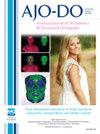直接印制矫治器疗法:为期 12 个月的应用和效果评估。
IF 2.7
2区 医学
Q1 DENTISTRY, ORAL SURGERY & MEDICINE
American Journal of Orthodontics and Dentofacial Orthopedics
Pub Date : 2025-01-01
DOI:10.1016/j.ajodo.2024.08.013
引用次数: 0
摘要
简介:直接印刷对准器(DPA)越来越受欢迎,它有可能简化生产流程,减少环境废物,并提供更强的适应性和定制能力。材料、软件和生产方面的进步促进了这一转变。虽然DPA在治疗更复杂的错合畸形方面可能具有更强的多功能性和应用性,但很少有研究对其有效性进行评估:方法:共对54名接受DPA治疗的患者进行了咬合改善、总体治疗时间和不良反应的评估。拟合回归模型以评估完善需求、最终同行评估等级(PAR)得分和自变量(包括矫治器总数和治疗适应症)之间的关联:上颌和下颌牙弓初始计划中的矫治器平均数量分别为 7.1 ± 2.9 和 5.1 ± 4.3。40.8%的患者(n = 20)需要重新调整。治疗前的 PAR 评分为 17.01 ± 7.93,治疗后有显著改善(86.6%),最终 PAR 评分为 2.25 ± 1.15。有 3 名参与者出现了轻微并发症。矫治需求与矫治器总数无关(几率比,1.05;95% 置信区间,0.94-1.18;P = 0.36)。有微弱证据表明,最终的PAR评分与配准器总数之间存在关联(几率比为-0.03;95%置信区间为-0.07至0.003,P = 0.07):根据这项初步的回顾性评估,DPA可用于治疗轻中度错颌畸形,显著降低PAR评分。然而,还需要更多的前瞻性研究来证实这些发现,并比较 DPA 与其他方法的相对优势。本文章由计算机程序翻译,如有差异,请以英文原文为准。
Directly printed aligner therapy: A 12-month evaluation of application and effectiveness
Introduction
Directly printed aligners (DPAs) are gaining in popularity, potentially streamlining manufacturing, decreasing environmental waste, and offering enhanced adaptation and tailoring. This transition has been facilitated by advances in materials, software, and production. Although DPAs may have enhanced versatility and application in the management of more complex malocclusions, there is little research evaluating their effectiveness.
Methods
A total of 54 patients undergoing treatment with DPAs were evaluated for occlusal improvement, overall treatment duration, and adverse effects. Regression models were fit to evaluate the association between the need for refinement, final peer assessment rating (PAR) score, and independent variables, including the total number of aligners and treatment indications.
Results
The mean number of aligners in the initial plan was 7.1 ± 2.9 and 5.1 ± 4.3 in maxillary and mandibular arches. Refinement was required in 40.8% (n = 20). The pretreatment PAR score of 17.01 ± 7.93 showed a significant improvement (86.6%), with a final PAR score of 2.25 ± 1.15. Minor complications were noted in 3 participants. The need for refinement was unrelated to the total number of aligners (odds ratio, 1.05; 95% confidence interval, 0.94-1.18; P = 0.36). There was weak evidence of an association between the final PAR score and the total number of aligners (odds ratio, −0.03; 95% confidence interval, −0.07 to 0.003, P = 0.07).
Conclusions
On the basis of this preliminary retrospective evaluation, DPAs may be used to manage mild-moderate malocclusion, producing a significant reduction in PAR score. Nevertheless, additional prospective research is required to confirm these findings and compare the relative merits of DPAs to alternatives.
求助全文
通过发布文献求助,成功后即可免费获取论文全文。
去求助
来源期刊
CiteScore
4.80
自引率
13.30%
发文量
432
审稿时长
66 days
期刊介绍:
Published for more than 100 years, the American Journal of Orthodontics and Dentofacial Orthopedics remains the leading orthodontic resource. It is the official publication of the American Association of Orthodontists, its constituent societies, the American Board of Orthodontics, and the College of Diplomates of the American Board of Orthodontics. Each month its readers have access to original peer-reviewed articles that examine all phases of orthodontic treatment. Illustrated throughout, the publication includes tables, color photographs, and statistical data. Coverage includes successful diagnostic procedures, imaging techniques, bracket and archwire materials, extraction and impaction concerns, orthognathic surgery, TMJ disorders, removable appliances, and adult therapy.

 求助内容:
求助内容: 应助结果提醒方式:
应助结果提醒方式:


